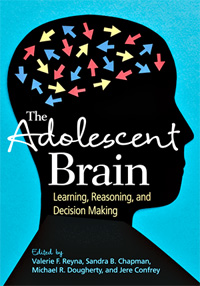
The Adolescent Brain highlights recent neuroscience discoveries related to how the brain develops and the implications for real-world problems.
UT Dallas Center for BrainHealth’s chief director, Dr. Sandra Chapman, was part of an interdisciplinary team that wrote and edited a new book, The Adolescent Brain: Learning, Reasoning and Decision Making.
The collaborative team included Valerie Reyna, professor and co-director of Cornell’s Center for Behavioral Economics and Decision Research; Michael Dougherty, professor of psychology at the University of Maryland; and Jere Confrey, professor of mathematics education at North Carolina State University.
A teenage brain undergoes big changes and does not look or function like an adult brain until well into a person’s 20s. The Adolescent Brain highlights recent neuroscience discoveries related to how the brain develops and the implications for real-world problems. The book discusses how to teach young people and prepare them to make healthy life choices.
“The adolescent brain is at a developmental crossroad,” Dr. Chapman said. “The immature stage of the frontal lobe development makes weighted decision-making very fragile and undependable; rational judgment is unfolding and dangerous choices are real options.”

Dr. Sandra Chapman says the adolescent brain’s frontal lobe is unreliable in making sound judgments.
She continued, “Untapped brain potential in adolescents exists, but in order to cultivate it, different educational strategies must be put in place to prepare teens to solve the complexities of future problems.”
The Adolescent Brain addresses the major changes in memory, learning and decision making experienced by adolescents as they mature, beginning with a review of the changes in brain anatomy and physiology based on extensive neuroimaging studies. The ensuing chapters examine the developing capacity of the adolescent brain, covering such topics as the underpinnings of intelligence and problem solving, strategies for training teen reasoning abilities, effectively teaching mathematical concepts, the effects of emotion on reasoning, and factors that promote teen engagement in health-related behaviors.
“Untapped brain potential in adolescents exists, but in order to cultivate it, different educational strategies must be put in place to prepare teens to solve the complexities of future problems.”
Dr. Sandra Chapman,
chief director of the Center for BrainHealth
“A major implication of the provocative research highlighted in this book is the contrast between adolescents’ cognitive skills, which are at a lifetime peak, and their frequent inability to use this competence in everyday decision making,” said Reyna, who co-edited the volume.
“But the evidence suggests that the way young people learn, reason and decide changes [during adolescence] and can be changed,” she continued. “We must move education beyond rote learning to fostering the cognitive skills essential for academic achievement and economic well-being in our knowledge-based economy. Higher cognition is a foundation critical for individuals and our country to be competitive. This volume introduces a new framework for interdisciplinary collaboration among scientists in neuroscience, psychology and education.”
The book finishes with a chapter by Reyna and doctoral student Christina Chick that integrates the behavioral and neuroscience evidence involving adolescent risky decision making. Chick and Reyna explain, for example, how massive loss of gray matter in late adolescence fits with the growth of adolescents’ ability to connect the dots and understand the underlying meaning of situations. This change facilitates recognition of danger and protects against unhealthy risk-taking.
The book is intended for researchers, students and professionals in the fields of cognitive neuroscience and psychology and for education policymakers and educators, especially in mathematics.